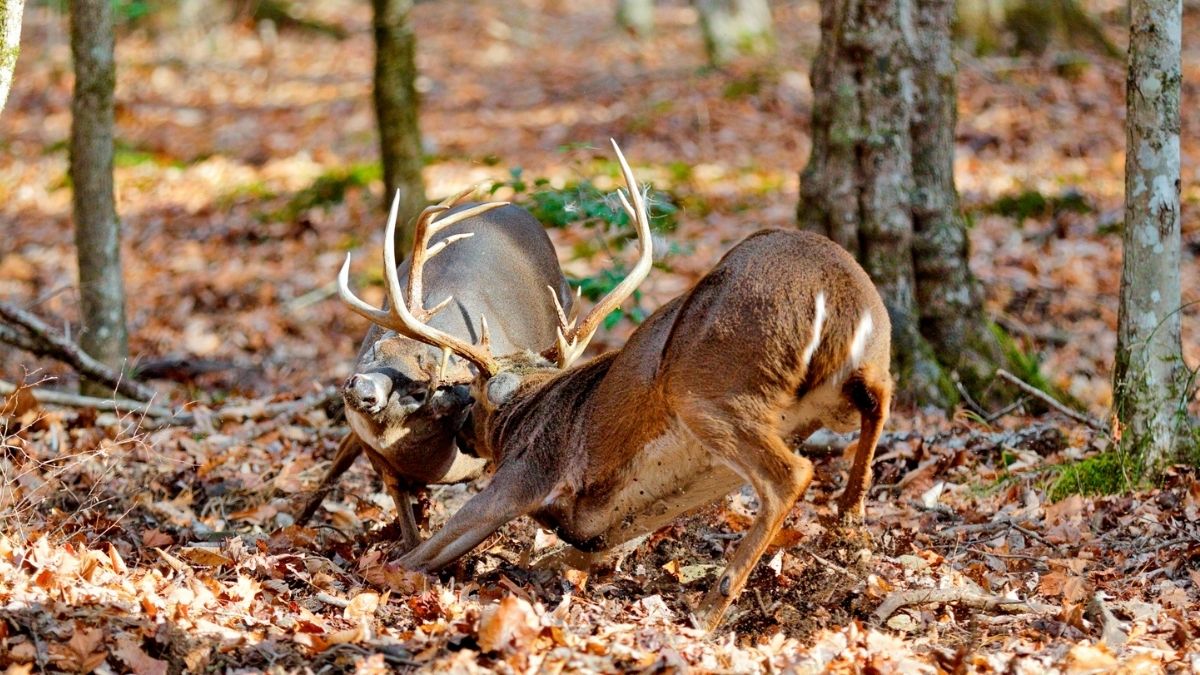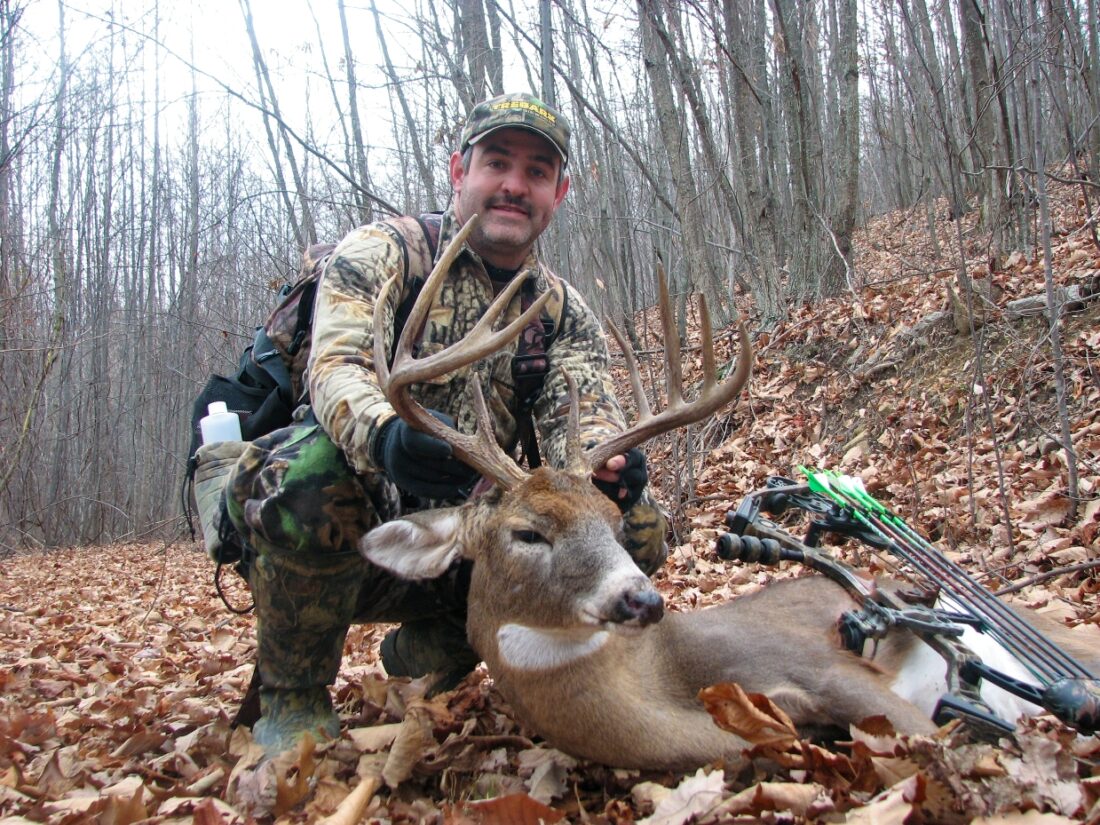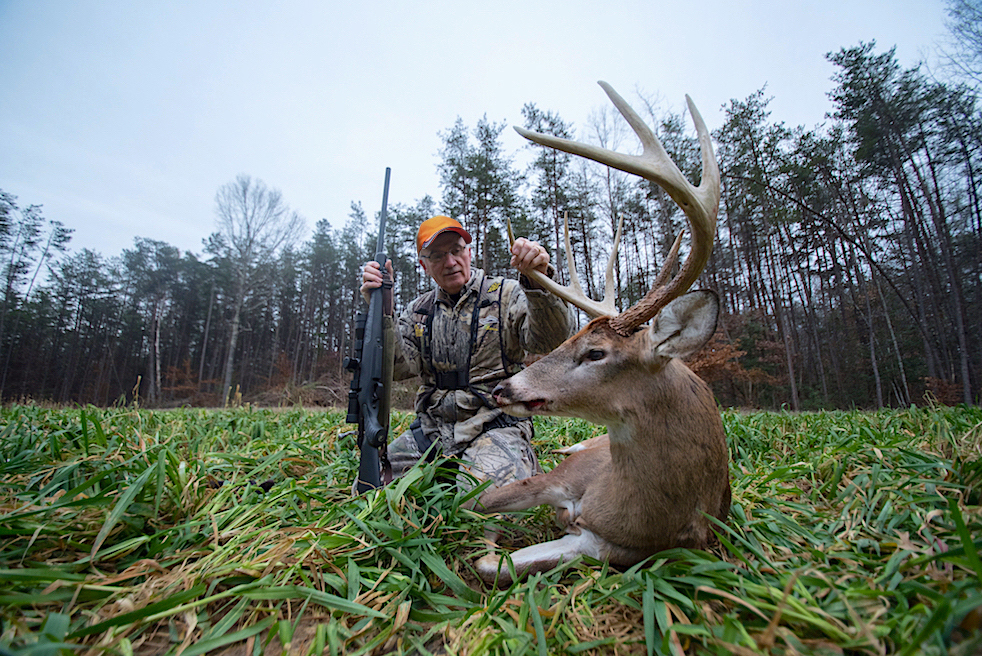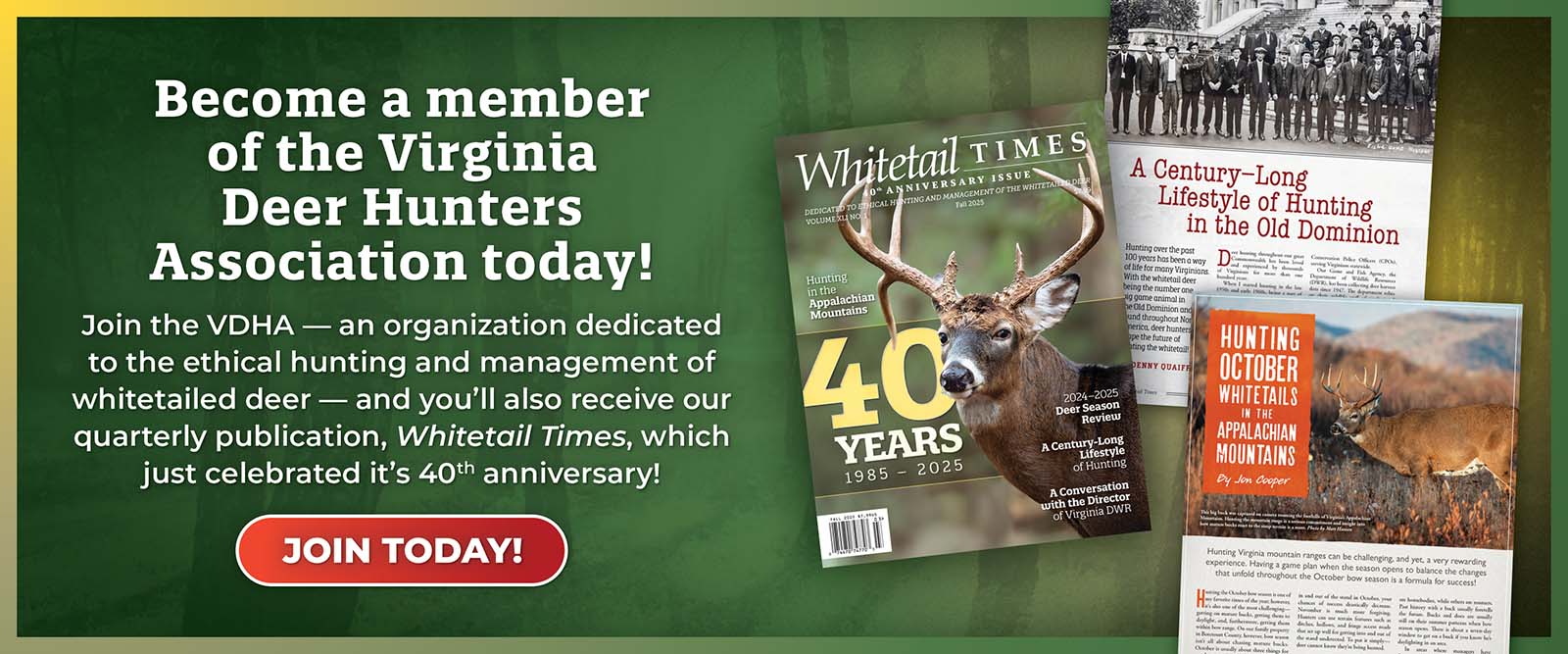The whitetail rut is a challenging, fast-paced, narrow-window of chance. This annual fall phenomenon is a time that big bucks throw caution to the wind and open the door of opportunity that deer hunters live for!

When the rut starts to heat up mature bucks are on the prowl. These big guys are sorting out who’s the big boss. The whitetail rut is what deer hunters set their sights on and being ready to face the challenge is have of the battle! Photo by Ryan Yoder
By Denny Quaiff for Whitetail Times
Huntin’ the rut is an exciting and challenging experience. Being prepared to confront all three phases of the rut is a commitment that sets a high standard. In this article I’ve reached out to three veterans with more than 100 years of combined experience chasing whitetails. Hopefully the advice they provide will enhance your chances and set the stage for success we all dream about!
Pre-Rut Phase with Matt Cooper
Life Virginia Deer Hunters Association (VDHA) member Matt Cooper, who lives in Fincastle, Virginia and hunts in Botetourt County, talks about hunting pre-rut bucks. Matt is an avid bow hunter and spends long hours during the early special archery season in a tree stand. I’ve known Matt for over 10 years and have high regard for his deer hunting success. Matt sets high standards as a hard mountain hunter when it comes to challenging mature bucks.

Matt Cooper is pictured here with one of the many Botetourt County bow kills to his credit. His bow hunting success is a tribute to the challenge that follows the early archery season. Photo courtesy of Matt Cooper
Matt what can you tell our readers about buck rub lines and how to take advantage of this fresh sign?
“To be honest, I only use rubs (horning is what I have always called it) in an overall perspective as just a piece to the puzzle. To elaborate on that, I don’t hunt specific rub lines as many hunters do. I have hunted them in the past but I have never had success on the older bucks to warrant hunting ‘horning’ or a rub line. However, I do pay attention to the size of rubs and their proximity to scrapes and/or other deer sign.
“When I find big ‘horning,’ I ask, ‘Why is that “horning” in that particular place with relation to thickets, known bedding areas along with buck/doe sign?’ then I go from there.” Matt went on to say, “I know hunters who try to analyze the size of the buck based on the tree as far as its diameter and how high their tines hit related to the main area of bark that has been removed. I never have been able to correlate that to antler size with any accuracy. Don’t get me wrong, finding big ‘horning’ always is exciting but I don’t hunt right on big ‘horning’ or rub lines in particular.”
Matt another question, do scrapes provide you with good stand locations during bow season and what is your approach?
“Yes, I’ve had several encounters with and killed a few mature bucks on scrapes RIGHT before the does start to become receptive. I have learned a whole lot about scrapes since trail cameras made the scene. Growing up, I always heard from the old timers that a buck will make a scrape, a doe will come along and pee in it when she is ready to breed. Then he will come back to check, smell that she is ready then track her down to ‘do the deed.’ However, that is hogwash. Scrapes are just a means of communication between the deer in that area and others close to that area. Bucks make scrapes in doe frequented areas like a feeding area or bedding area to keep ‘tabs’ on those does because the does also like to be social.”
Matt continued, “I love to find big fresh scrapes. It makes you think you are getting closer and you are. However, 95 percent (ish) of the scrape activity is done under the cover of darkness. Yes, you can hang your stand right then and there in the middle of October and sit on it for the next two Saturdays and Sundays and never see a good buck. It will be worked and there will be big fresh tracks in it but you still don’t see a mature buck. That’s because those mature bucks do not get on their feet in the daylight until the very latest of the pre-rut, which is the very last few days of October and the first week of November. After the first week or so of November, all bets are off on scrape hunting because the does are starting to come in and when those older age class bucks either feel, smell or sense the rut is happening, they will be on their feet looking for the very first receptive doe.”
Matt it’s been documented that the first week of November during the late pre-rut has been proven to find bucks on the move searching for hot does. What can you tell us about this timeline from your perspective?
“Yes, I believe the first week and a half in November is the best time to kill a mature buck especially, one you have been keeping tabs on by pictures or you know is in your area to hunt. My brother, Jon and I, have seen bucks move miles covering ground during that particular time. Both bucks that we know are there and others coming through just looking. In our area, November 8-13 has historically been when the older age class bucks first get on their feet in the daylight. I have good friends and acquaintances who have killed mature bucks prior to that but I never have and I have spent a ton of time in a tree during that time.”
If you could point out one more thing that should not be overlooked when the rut is starting to heat up?
“If you have the time to hunt during the very last of the pre-rut, then just go hunting on the best sign you have found and keep a positive attitude! It is one of the best times to be in the woods especially if you have been keeping tabs on a particular buck!”
Prime Rut Phase with Nick Hall, Jr.
Nick Hall, Jr., is one of those hunters that I’ve had the pleasure watch mature and become a seasoned veteran. Nicky has been hunting with his dad and I since he was old enough to tag along. Today his commitment and dedication rank high in my book and his excitement surrounding the thrill of the hunt is priceless!

Nick Hall, Jr. is a hard hunter who takes the prime rut seriously. Nicky shot this mature eight-pointer on opening day of rifle season while still hunting with his muzzleloader. The Amelia County buck responded to the grunt tube and came charging in when Hall came back with the doe bleat. Photo by Denny Quaiff
Nicky, I know you spend a lot of time hunting during the peak of the rut. What do you recommend for our readers when we talk about scent control?
“The control of human scent should be at the forefront of every hunter’s mind all deer season long, especially during the rut. As a hunter I use every trick I can think of in an attempt to fool a mature buck’s nose and this always starts hours before I even think about entering the whitetail woods. It is imperative to shower with a scent-eliminating body soap and shampoo before hunting. Your drive to the woods needs to stay as scent-free as possible. To that point I never take that drive while wearing my hunting attire. My hunting clothing is stored in a scent-secure tote and put on after I get out of my vehicle. After fully dressed and ready to start making my way into that buck’s backyard, I will spray my entire body and boots with one of the many scent elimination sprays on the market.”
Nicky continued, “Now that I’m ready to walk to my stand comes the most important piece of the whitetail puzzle, the wind! All of the above listed efforts will be for naught if your hunting the wrong wind. If what is left of your human scent, and there is always scent, blows directly into his bedroom you will not be successful. A good stand-hunting wind may not be a good stand-approach wind. Keeping the wind in mind 100 percent of the time will dramatically increase your odds.”
With bucks walking on their own and checking for hot does during this prime time, when and what do you reach in your bag of tricks for that will hopefully bring a mature buck in range?
“We all have that bag of tricks that we hope will enhance our chances. I never enter the woods in November without a doe bleat and a grunt call. Careful not to overuse the two, I am always listening for the sounds they create. The vocal indication that a hot doe is being chased by an excited buck is knowledge that you can exploit with the use of both of the before mentioned calls. My biggest trick is actually no trick at all. It cannot be purchased at Dicks or Walmart and you can’t put it in your camo fanny pack,” Nicky explains. “Being aware of what stage of the rut your deer are in is paramount in knowing when to hunt and what ‘tricks’ to use while you are hunting.”
Nicky, you and I talk a lot throughout the season checking wind directions and stand locations. What’s your thoughts about over hunting a stand and how do mature bucks respond to this type of pressure?
“The fastest way I know to relocate a mature whitetail is to over-hunt him. Hunting a particular location over and over again is never a good idea while hunting a mature buck. It is no accident he lived long enough to grow those huge antlers, and the key to his survival is staying clear of us. A stand or blind that always has a hunter in it is not a location he wants to be in. Again, always keep the wind in mind and put limits on the frequency you hunt any location. I have killed some of my largest buck while waiting for the right wind for an entirely different stand.”
We all know that bucks are searching for estrous does during this prime time and may show up at any time of the day. What’s your game plan during this narrow window of opportunity?
“Scent control, wind direction and stand selection are all very necessary if you want to have big buck success but none of those are as important as having a sore butt. Logging as many hours as humanly possible in the woods during the month of November is imperative in my opinion. You can’t kill him if you’re not out there!”
Is there just one more thing from your experiences that you would like to share?
“Let’s face it, hunting every day is not possible for the average sportsman. I use the moon phase as a tool to help in deciding which days to focus on during the rut. There are several apps I use that predict deer movement and feeding patterns in coalition with the moon phase. While not 100 percent, I find them to be amazingly accurate and a good resource for deciding what days to try to be in the woods.”
Post-Rut Phase with Hank Tassitano
Hank Tassitano has been a friend of mine for over 30 years and one of my most highly respected deer hunters. Hank hunts throughout all three phases of the rut and does not let the extreme cold weather conditions during the post-rut slow him down.

Hank Tassitano hunts throughout all three phases of the rut. This late-season Fluvanna County eight-pointer is another fine example of his commitment. Hank’s dedication sets a high standard and his years of experience provide knowledge we can all learn from. Photo courtesy of Hank Tassitano
Hank, we all know that the prime breeding action can shut down like turning off a light switch and bucks moving all hours of daylight suddenly comes to an end. When most deer hunters are home watching college and pro football on ESPN what keeps you focused on late-season deer hunting?
“A couple of main factors I enjoy about late-season deer hunting. First the cold weather will get the deer back feeding during daylight and second there are less hunters in the woods. The added bonus if you are lucky to have a young doe come into estrous, you will find any mature back in the immediate area on his feet.”
Research studies tell us that mature bucks have returned to their home range and live in small hide-outs after the prime rut. Would you share with our readers how you approach this post-rut phase?
“From my early season scouting I not only focus where deer are feeding in more open fields or woods, I also run cameras back along thick creek bottoms, edges of cutovers, and pine or cedar thickets. It shows me where mature bucks are bedding. If they’re not shot early in the season, they’ll be back using these places again to bed late season. I will then focus on the closest food source to that area once my cameras capture a buck using one of these areas again.
“I run my cameras all year long. When we get into the later part of the season it can tip you off where mature bucks might be staying and which bucks have come back to their home range. Or you might have a new buck that got pushed into your hunting area.”
Hank, we know that a second rut usually takes place in early December and this is very short-lived. What have you learned about the second rut and how do you hunt these deer?
“I will focus on main food sources—that might be an agriculture field, food plot, or an oak ridge. I spend many hours scouting right after deer season ends each year and also scout some carefully during the season so I know where deer will be feeding all season long. Late season it’s about the food and your best chance to catch a doe fawn in heat.”
With bucks losing 25 to 35 percent of their body weight during the rut, what food sources do you look for in the late season and how do you hunt these locations?
“For late-season hunts around food sources I will only hunt afternoons during these cold conditions. I see way more deer in the afternoons then mornings, plus you have less chance of bumping off deer in the afternoon. It’s important to not get busted this time of the season when hunting a food source because deer are still reacting to prior hunting pressure and they will stop using this during daylight if you get caught a couple times. On one of my properties I’m picked up from my stand by vehicle which soft pushes the deer off the field. I can hunt that place often because they don’t see me climb down from my stand.”
Do you have anything else that you could offer our deer hunters from your many years of experience?
“I have found that to gain a big edge on scent control I started using the Ozonics. I don’t fall for gimmicks and had to be persuaded to try one my buddy had. The first time I killed a big buck using the Ozonics made me a believer. I got his attention with my grunt tube. I watched him stop a number of times to scent check as he circled downwind until he hit 15 yards and I put an arrow though his lungs. It made me wonder how many bucks have I not seen over the years that had winded me.”
Hank concluded by saying, “Go out hunting with the right frame of mind and be patient. Do your homework and you will put yourself in the position to get lucky!”
Summary
It was a real pleasure for this editor to interview these three veteran hunters that we don’t see on TV. The information they have provided with the things that have and have not worked for them is invaluable. Successfully hunting free-ranging, mature whitetail bucks under fair chase conditions is a tall order. Deer hunters that accept this annual commitment are dedicated and demand of themselves a high level of excellence.
When the rut starts taking shape consider some of these tips that might be just what it takes to close the deal. However, the most important things we all face every time we hunt is safety. Enjoy the upcoming hunting season and be mindful of safe hunting practices—you owe it to your family, fellow hunters, and yourself!
©Virginia Deer Hunters Association. For attribution information and reprint rights, contact Denny Quaiff, Executive Director, VDHA.


